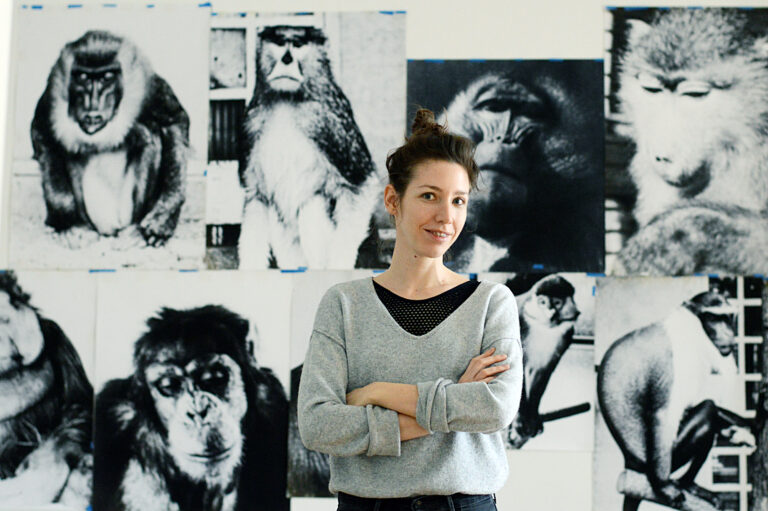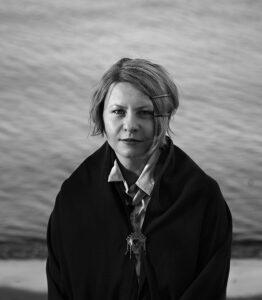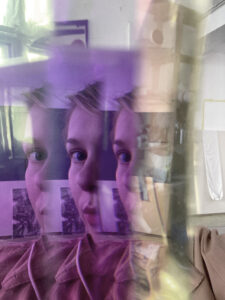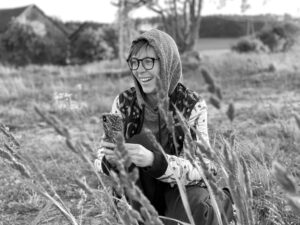Andrea Palašti

– b.1984 – is a visual artist based in Novi Sad, Serbia. She works across artistic, curatorial and pedagogical boundaries focusing on issues of cultural geography, the responsibilities of history and its impact on the present, through photography, video and illustrated lectures. Since 2014, she has teamed up with the picture researcher Daniel Popović (b.1978) to investigate picture archives and their potential to unveil a nuanced understanding of the world. She is a board member of the SULUV gallery, and associate professor at the Academy of Art in Novi Sad where she teaches Elements of Visual Art, blending her collaborative artistic research projects with educational strategies.
I grew up in Serbia, during the war and in the immediate post-conflict period, as a child of a mixed marriage, constantly shifting between speaking Hungarian to my mother and Croatian to my father. Belonging to a Hungarian and Croatian minority and living and growing up in Serbia was quite a challenge. But it was not only about the language, it was the experience of living with multiple cultures, cultures which at one point in different histories had been very hostile to one another. I often joke with the idea that I am inevitably all of the three nationalities at the same time: an enemy, a criminal and the ally, an avenger and the victim, a spy, a traitor and the betrayed, an occupier and the occupied. These experiences taught me to acknowledge others and empowered me to come up with different styles of thinking and different ways of talking. This in turn greatly informed my artistic practice as I was able to take on different identities, and open up my work to alternative narratives, conflicting stories, troubled histories in a more buoyant way. I work collaboratively and interdependently, with my partner, my parents, my students, my fellow artists, curators, journalists, scientists or historians, often working with the picture collections of different public companies and private individuals as a means to discover stories outside the official histories. I see these stories as incidental school lessons through which I learn and unlearn and ask lots of questions. So, let me guide you through some of these stories.
This is me and my brother Ivan1, photographed by my mother Cuni in the ‘90s on the balcony of our apartment. Equipped with an old Zenit camera and a teleobjective lens, Cuni was an inspiring photographer and a fantastic instructor! She taught us how to pose and when to smile. She took hundreds of photographs during the Yugoslav wars, sending them to our relatives in Szeged and Vinkovci.
When we finally moved out of our parents’ home, the only person there was left to be photographed was my father Ivica but he was not very enthusiastic about being photographed. My mother was very disappointed by this, stating that she was giving up photography forever because my father is always in the same place with the same face2.
Animals in the Zoo are also stuck in one place. These photographs3 are a tiny part of the Historical Research & Documentation centre of the Schönbrunn Zoo. They belong to the ‘Primates’ box, collected by the renowned Zoo director Otto Antonius. And this is Emil4, an Orangutan media star and a favourite attraction – until he became extremely fat and so depressed that he refused all forms of contact. After his death, Emil’s body parts were distributed around various scientific institutions and museum collections, so I went in search of them.
Otto Antonius, the Zoo director, was also a horse enthusiast, or to be more precise an equine scientist, collecting thousands of different horse pictures and illustrations5. He was interested in cross breeding studies and attempts at breeding back – specifically in bringing back the extinct wild European tarpan horse. When the Allied troops were closing in on Vienna to liberate the city, Otto Antonius took his own life and that of his wife inside the Zoo.
My mother is also a passionate picture collector. She collects supermarket catalogues and makes shopping lists in the form of these beautiful collages6 in order not to forget what to buy.
My mother inherited this passion for collecting from her grandfather Agoston. He was a travelling salesman for the Čakovec factory, selling silk thread and underwear. This set of scans7 are from his collection of the Képes Vasárnap (Picture Sunday 1937-1944) collected between 1941 and 1944. Képes Vasárnap was an illustrated weekly supplement of the Pesti Hírlap (Daily Pest, 1841-1944) from Budapest, today known for its journalists who worked undercover for a pirate radio. Everything they were not allowed to write about in the newspaper due to censorship they dealt with in the Hungarian Freedom Radio.
Living undercover and hiding one’s true identity sometimes were a means of survival. These photographs8 were taken during the Holocaust by Jewish families who went into hiding as tourists abroad. Often using false documents, these families were buying themselves an apparent route to safety. Most of the time, properly forged documents were not enough to ensure survival undercover. It was also equally important to have the ‘proper’ appearance, a new personality and to be able to act in a ‘normal’ way. The photographs were often made as snapshots of happy moments, but only when we find out about the context of the image does the contrast between the actual truth and the played out truth increase. Through these acts they were misleading the viewer, they became invisible, but not in the way that they could not be seen but in a way that they would not be interpreted as Jews.
Currently I am developing a research investigation into the Pine processionary caterpillars at the Marjan Forest Park in Split. Described as a great villain and the most destructive species of pines and cedars, and also harmful to humans and pets causing allergies and irritations to the skin, hikers at the Park seem to have taken on the moral obligation and right to exterminate them. As though there is a competition as to who is able to tread on and crush a longer line of the processionary caterpillars, their crushed bodies9 form a visual pattern on the hiking path, inviting others to join in the stomping. Following blindly the violent example of another – do we justify this killing by the economic catastrophe the caterpillars produce, and the skin rashes they give us if we try to sniff them? Who gets to decide what lives or what dies?
So I got to a point where I had to ask myself and to think about what the pine processionary caterpillars have in common with the family photographs of Jews in hiding or my great-grandfather’s collection of propaganda photos? Or how do my mother’s shopping lists correspond to the horses of Otto Antonius? And what could the Apes of the Schönbrunn Zoo tell us about my father, my brother and myself? What does it mean for all these things to (co)exist in my biography, on a single piece of sheet/screen, as an index print10? Indeed, what has been left out from an image speaks much more than what the photos really show.
Text is written in collaboration with Jelena Vesić (2022).
1Image: A1 - A11: Andrea and Ivan / 1993 - 2001 / author: Marta Palasti / Source: family album, courtesy of the artist.2Image: B12 - B20: Tata / 2013 / author: Marta Palasti / Source: family album, courtesy of the artist.
3Image: C21 - C28: Primates / c. 1925-1945 / Source: Archive of the Schönbrunn Zoo: Geschichtsforschung & Dokumentation / Courtesy: Schönbrunn Zoo, courtesy of the artist.
4Image: C29: Emil / c. 1937 / Source: Archive of the Schönbrunn Zoo: Geschichtsforschung & Dokumentation / Courtesy: Schönbrunn Zoo, courtesy of the artist.
5Image: D30 - D39: Hippology / c. 1925-1945 / Source: Mappe 28, Archive of the Schönbrunn Zoo: Geschichtsforschung & Dokumentation / Courtesy: Schönbrunn Zoo, courtesy of the artist.
6Image: E40 - E48: Shopping list / 2013 - ongoing / author: Marta Palasti / Source: family album, courtesy of the artist.
7Image: F49 - F58: Pictures Sunday / 1941 - 1944 / Source: "Pest Diary", Hungarian weekly magazine, courtesy of the artist.
8Image: H59 - H67: Andrija Sekelj / c. 1940 - 1944 / Source: Portraits and Memories, The Federation of Jewish Communities in Serbia / Courtesy: Andrija Sekelj, courtesy of the artist.
9Image: J68 - J76: The Pine Processionary / 2022 / author: Andrea Palasti, courtesy of the artist.
10Image: Printscreen of the Indexprint lecture / 2022 / author: Andrea Palasti, courtesy of the artist.

– 1984 – je vizuelna umetnica iz Novog Sada. Radi na prelazu umetničkih, kustoskih i pedagoških praksi u kojima akcenat stavlja na pitanja kulturne geografije, istorije i svakodnevnog života, eksperimentišući sa fotografijom, video zapisima i ilustrovanim predavanjima. Od 2014. godine udružuje se sa Danielom Popovićem (1978), istražujući slikovne arhive i njihov potencijal da razotkriju različite nijanse razumevanja sveta. Trenutno radi kao vanredna profesorica na predmetu Likovni elementi, na Akademiji umetnosti u Novom Sadu, povezujući svoje kolaborativne umetničke projekte sa obrazovnim strategijama.
Odrasla sam u Srbiji, tokom rata i neposrednog posleratnog perioda, kao dete iz mešovitog braka, komunicirajući sa svojom majkom na mađarskom, sa ocem na hrvatskom jeziku. Pripadati mađarskoj i hrvatskoj manjini, a živeti i odrastati u Srbiji bio je popriličan izazov. Međutim nije se sve svodilo na jezik, bilo je i do iskustva življenja među različitim kulturama, kulturama koje su, u određenom trenutku u različitim istorijama, bile vrlo neprijateljski nastrojene jedne prema drugima. Često znam da se našalim kako sam neizbežno, sa sve tri nacionalnosti istovremeno: neprijatelj, prestupnik, ali i saveznik, osvetnik i žrtva, špijun, izdajnik i izdani, okupator i okupirani. Ovakva iskustva su me naučila da prihvatim druge i drugačije i osnažila me da iznađem različite vidove mišljenja i govora. To je, kao rezultat, u velikoj meri uticalo na moje umetničko stvaralaštvo, jer sam bila u stanju da poprimim različite identitete i otvorim svoj rad za alternativne narative, suprotstavljene priče i problematične istorije na nepretenciozan način. Stvaram u saradnji i dijalogu sa svojim partnerom, roditeljima, studentima, umetnicima, kustosima, novinarima, naučnicima ili istoričarima, radeći često sa kolekcijama fotografija raznih javnih preduzeća i privatnih lica kao sredstvom otkrivanja priča van domena zvanične istorije. Za mene ove priče predstavljaju usputne školske lekcije kroz koje učim, napuštam ranije naučeno i postavljam brojna pitanja. Stoga, dozvolite mi da vas provedem kroz neke od ovih priča.
Ovo sam ja i moj brat Ivan1. Fotografisala nas je Cuni, naša mama, tokom 90-ih godina na terasi stana. Opremljena starim fotoaparatom marke Zenit i teleobjektivom, Cuni je bila fotografkinja koja nadahnjuje, ali i fantastična instruktorka! Naučila nas je kako da poziramo i kada da se nasmešimo. Napravila je na stotine fotografija tokom građanskog rata u Jugoslaviji i slala ih našim rođacima u Segedin i Vinkovce. Kada smo se brat i ja konačno iselili iz porodičnog doma, moj otac Ivica ostao je jedini za fotografisati. Međutim on nije pokazivao previše entuzijazma kad se radilo o poziranju pred fotoaparatom. Cuni je bila izuzetno razočarana, i odlučila da zauvek odustane od fotografije zbog toga što je moj otac uvek na istom mestu sa istim izrazom lica2.
Životinje u zoološkom vrtu su takođe zaglavljene na jednom mestu. Ove fotografije3 su samo delić kolekcije Centra za istorijsko istraživanje i dokumentaciju zoološkog vrta u Šenbrunu. Pripadaju kutiji „Primata“, a sakupio ih je slavni direktor ovog zoološkog vrta Oto Antonijus. A ovo je Emil4, bio je medijska zvezda i omiljena atrakcija svim turistima u zoološkom vrtu – sve dok nije postao pregojazan i toliko depresivan da je odbijao svaki kontakt. Nakon smrti, Emilovi ostaci postali su deo naučnih institucija i muzejskih zbirki, a ja sam se dala u potragu za njima. Oto Antonijus, direktor zoo vrta, bio je takođe i zaljubljenik u konje, odnosno hipolog, koji je sakupio na hiljade različitih fotografija i ilustracija konja5. Zanimao se za studije ukrštanja rasa i pokušaje vraćanja u život izumrlih vrsta – naročito za vraćanje tarpana, izumrlog evropskog divljeg konja. Dok su savezničke trupe stezale obruč oko Beča sa ciljem da oslobode grad, Oto Antonijus oduzeo je život sebi i svojoj ženi unutar zoološkog vrta.
Moja majka je, takođe, strastvena kolekcionarka. Sakupljajući kataloge iz supermarketa, ona pravi spiskove za kupovinu u vidu ovih prelepih kolaža6, kako ne bi zaboravila šta trebamo da joj kupimo. Moja majka je nasledila svoju strast za prikupljanjem od svog dede Agoštona. On je radio kao putujući trgovac za fabriku iz Čakovca, prodavajući svilen konac i donji veš. Ovaj komplet skeniranih fotografija7 su iz njegove kolekcije časopisa Képes Vasárnap (Ilustrovana nedelja 1937. – 1944.), koje je prikupio između 1941. i 1944. godine. Képes Vasárnap je bio ilustrovani nedeljni dodatak novina Pesti Hírlap (Peštanske dnevne novine, 1841. – 1944.) iz Budmipešte, danas poznatih po svojim novinarima koji su zapravo radili tajno za jedan piratski radio. Sve ono o čemu im zbog cenzure nije bilo dozvoljeno da pišu u novinama, oni su obrađivali na Mađarskom slobodarskom radiju. Ponekad je živeti tajno i skrivati svoj pravi identitet bio način preživljavanja. Ove fotografije8 su tokom Holokausta napravile jevrejske porodice koje su se skrivale pretvarajući se da su turisti u inostranstvu. Koristeći često lažna dokumenta, ove porodice su sebi osiguravale put ka prividnoj sigurnosti. Većinu vremena, valjano falsifikovana dokumenta nisu bila dovoljna kako bi preživljavanje pod lažnim identitetom bilo zagarantovano. Bilo je takođe podjednako važno posedovati „ispravnu“ spoljašnost, novu ličnost, kao i biti u stanju ponašati se „normalno“. Fotografije su načinjene kao snimci srećnih trenutaka, međutim tek kad otkrijemo kontekst iza ovih slika, povećava se kontrast između prave istine i one odglumljene. Ovakvim činovima oni bi obmanjivali posmatrača, postajali bi nevidljivi, ali ne tako da ih se ne može videti, već da ih se ne može interpretirati kao Jevreje.
Trenutno razvijam istraživanje o gusenicama borovog četnika park-šume Marjan u Splitu. S obzirom da su opisane kao najveći negativac i najdestruktivnija vrsta po drveće bora i kedra, a takođe su štetne i po ljude i kućne ljubimce – kojima izazivaju alergije i iritacije na koži – šetači u ovom parku su, čini se, uzeli na sebe moralnu obavezu i dali sebi za pravo da ih istrebe. Kao da postoji takmičenje u tome ko je u stanju da izgazi i zgnječi dužu kolonu gusenica borovog četnika. Njihova spljeskana tela9 formiraju vizuelne šablone na pešačkoj stazi, pozivajući i ostale da se pridruže gaženju. Da li, slepo sledivši nasilni primer drugih, opravdavamo ovo ubijanje ekonomskom katastrofom koju gusenice proizvode, kao i kožnim osipima koje nam izazivaju ukoliko pokušamo da ih pomirišemo? Na kome je da odluči šta će živeti, a šta umreti?
I tako sam došla do tačke kad sam morala da se zapitam i promislim šta to gusenice borovog četnika imaju zajedničko sa porodičnim fotografijama Jevreja koji se skrivaju ili sa kolekcijom propagandnih fotografija moga pradede? Ili u kakvoj vezi stoje spiskovi za kupovinu moje majke i konji Otoa Antonijusa? I šta bi to majmuni Šenbrunskog zoološkog vrta mogli da nam kažu o mom ocu, mom bratu i meni? Koje značenje ima činjenica da sve ove stvari (ko)egzistiraju u mojoj biografiji, na jednom parčetu papira/ekrana, u vidu indeksa fotografija10? I zaista, ono što je sa fotografije izostavljeno govori mnogo više od onoga što ona stvarno prikazuje.
Tekst je napisan u saradnji sa Jelenom Vesić (2022)
1Slika: A1 - A11: Andrea i Ivan / 1993 - 2001 / autor: Marta Palašti / Izvor: porodični album, ljubaznošću umetnice.2Slika: B12 - B20: Tata / 2013 / autor: Marta Palašti / Izvor: porodični album, ljubaznošću umetnice.
3Slika: C21 - C28: Primati / c. 1925-1945 / Izvor: Arhiv Zoološkog vrta Šenbrun: Istorijski i dokumentacioni centar / Ljubaznošću: Zoološki vrt Šenbrun, ljubaznošću umetnice.
4Slika: C29: Emil / c. 1937 / Izvor: Arhiv Zoološkog vrta Šenbrun: Istorijski i dokumentacioni centar / Ljubaznošću: Zoološki vrt Šenbrun, ljubaznošću umetnice.
5Slika: D30 - D39: Hipologija / c. 1925-1945 / Izvor: Mappe 28, Arhiv zoološkog vrta Šenbrun: Istorijski i dokumentacioni centar / Ljubaznošću: Zoološki vrt Šenbrun, ljubaznošću umetnice.
6Slika: E40 - E48: Šoping lista / 2013 - u toku / autor: Marta Palašti / Izvor: porodični album, ljubaznošću umetnice.
7Slika: F49 - F58: ‘Slika Nedelje’ / 1941 - 1944 / Izvor: ‘Slika Nedelje’ je nedeljni dodatak mađarskih novina "Peštanski dnevnik", ljubaznošću umetnice.
8Slika: H59 - H67: Andrija Sekelj / v. 1940 - 1944 / Izvor: Portreti i sećanja, Savez jevrejskih opština Srbije / Ljubaznošću: Andrija Sekelj, ljubaznošću umetnice.
9Slika: J68 - J76: Povorka borovog četnika / 2022 / autor: Andrea Palašti, ljubaznošću umetnice.
10Slika: Index print / 2022 / autor: Andrea Palašti, ljubaznošću umetnice.

– 1984 – újvidéki képzőművész. A művészeti, kurátori és pedagógiai gyakorlatok metszéspontjában dolgozik, amelyben a kultúrföldrajzi, történelmi és hétköznapi kérdéseket helyezi előtérbe, valamint fotózással, videókkal és illusztrált előadásokkal kísérletezve. 2014 óta dolgozik együtt párjával, Daniel Popović (sz. 1978) képkutatóval, a képarchívumok feltárásán és a világ árnyalt megértésének feltárásában. Jelenleg egyetemi előadóként dolgozik az újvidéki Művészeti Akadémia ‘Művészeti Elemek’ tantárgyát tanítva, sokszor egybevonva a saját művészeti projektjeit oktatási stratégiákkal.
Szerbiában nőttem fel, a háború alatt és közvetlenül a konfliktus utáni időszakban, vegyes házasság gyermekeként, folyamatosan váltottam aközött, hogy anyámhoz magyarul beszéltem, apámhoz pedig horvátul. Szerbiában élni és felnőni, valamint, ugyanabban az időben magyar és horvát kisebbséghez tartozni komoly kihívást jelentett. De ez nem csak a nyelv miatt volt, hanem a sokféle kultúrával való együttélés élményéről, olyan kultúrákkal, amelyek különböző történelmek egy pontján kimondottan ellenségesek voltak egymással. Gyakran viccelek azzal a gondolattal, hogy óhatatlanul mindhárom nemzetiséggel egyszerre: ellenség, bűnöző és szövetséges vagyok, bosszúálló és áldozat, kém, áruló és elárult, megszálló és megszállt. Ezek a tapasztalatok megtanítottak arra, hogy elfogadóbb legyek mások iránt, és képessé tettek arra, hogy különböző gondolkodási és beszédmódokat dolgozzak ki. Ez viszont nagyban befolyásolta a művészi gyakorlatomat, mivel képes voltam felvenni ezeket a különböző identitásokat, és lendületesebb módon megnyitni munkámat alternatív narratíváknak, egymásnak ellentmondó történeteknek, akár zaklatott történetek előtt is. Együttműködve és egymástól függő módon dolgozom a párommal, szüleimmel, tanítványaimmal, művésztársaimmal, kurátorokkal, újságírókkal, tudósokkal és történészekkel. Gyakran különböző állami vállalatok és magánszemélyek képgyűjteményeivel dolgozom, olyan történeteket keresve melyek nem kerültek bele a hivatalos történelembe. Ezeket a történeteket mellékes iskolai leckéknek tekintem, amelyeken keresztül tanulok, feledek, és rengeteg kérdést teszek fel. Tehát hadd kalauzoljalak végig néhány ilyen történeten.
Ez én vagyok és a bátyám, Iván1. Cuni édesanyám fényképezett bennünket a ’90-es évek alatt a lakásunk erkélyén egy régi Zenit fényképezőgéppel és egy kölcsönkért teleobjektívvel. Cuni inspiráló fotós és fantasztikus oktató volt! Megtanított minket pózolni és mikor mosolyogni. Több száz fényképet készített a Jugoszláv háború idején, melyeket folyamatosan küldött a szegedi és vinkovci rokonainknak. Amikor végül elköltöztünk a szüleink otthonából, az egyetlen aki otthon maradt, az apám, Ivica volt, de ő nem nagyon lelkesedett a fotózásért. Édesanyám nagyon csalódott volt emiatt, és kijelentette, hogy örökre felhagy a fotózással, mert apám mindig ugyanazon a helyen van ugyanazzal az arckifejezéssel2.
Az állatkert állatai is egy helyen ragadtak. Ezek a fényképek3 a Schönbrunni Állatkert Történeti Kutató- és Dokumentációs Központjának apró részét képezik. A „Főemlősök” dobozba tartoznak, amelyet a neves állatkert igazgató, Otto Antonius gyűjtött össze. Ez pedig Emil4, egy orángután médiasztár és kedvenc állatkerti attrakció – egészen addig, amíg rendkívül meghízott és annyira depressziós lett, hogy megtagadta a kapcsolattartás minden formáját. Halála után Emil testrészeit különféle tudományos intézményekbe és múzeumi gyűjteményekbe terjesztették, így elmentem megkeresni őket. Otto Antonius, az állatkert igazgatója lórajongó is volt, pontosabban lótudós, és az évek folyamán több ezer különböző lóképet és illusztrációt gyűjtött össze5. Érdekelték a keresztezési vizsgálatok és a visszatenyésztési kísérletek – konkrétan a kihalt vad tarpán ló visszahozása. Amikor a szövetséges csapatok közeledtek Bécs felé, hogy felszabadítsák a várost, Otto Antonius az állatkertben kioltotta felesége és saját életét.
Édesanyám is szenvedélyes képgyűjtő. Szupermarket katalógusokat gyűjt, és bevásárlólistákat készít e gyönyörű kollázsok formájában6, hogy ne felejtse el, mit kell vásároljon. Anyám nagyapjától, Ágostontól örökölte ezt a gyűjtőszenvedélyt. Ágoston a Csakovec gyár utazó eladója volt, selyemszálat és fehérneműt árult. Ez a képsorozat7 a Képes Vasárnap 1941 és 1944 között gyűjtött gyűjteményéből való. A Képes Vasárnap a budapesti Pesti Hírlap (1841-1944) illusztrált heti melléklete volt, ma arróll ismert, hogy újságírói párhuzamosan egy kalózrádiónál is dolgoztak. Mindenről, amiről a cenzúra miatt nem írhattak az újságban, a Magyar Szabadság Rádióban elhangzott. A rejtett élet, pontosaban a valódi identitás elrejtése a túlélés eszköze is lehet. Ezeket a fényképeket8, a Holokauszt idején, külföldön turistaként bujkáló zsidó családok készítették. Gyakran hamis dokumentumokat használva ezek a családok látszólagos biztonságot vásároltak maguknak úgy, hogy turistáknak álcázták magukat. Legtöbbször a megfelelően hamisított dokumentumok nem voltak elegendőek a titkos túlélés biztosításához. Ugyanilyen fontos volt a „megfelelő” megjelenés, az új személyiség és a „normális” cselekvés. A fényképek gyakran a boldog pillanatok pillanatfelvételeiként készültek, viszont egy „örömteli” családi pillanat egészen mást jelenthet, ha felfedezzük a kép keletkezésének körülményeit. Ezekkel a tetteikkel félrevezették a nézőt, láthatatlanná váltak, de nem úgy, hogy ne lássák, hanem úgy, hogy ne ismerjék fel őket zsidókként.
Jelenleg a fenyő-körmeneti hernyók után érdeklődöm, a Split városi Marjan-erdőparkban. A körmeneti hernyókat nagy bűnözőknek tekintik mert súlyos károkat okoznak a fenyőknek és cédrusoknak, valamint az emberre és a háziállatokra is ártalmasak, allergiát és bőrirritációt okozhatnak ha közvetlen közelükbe kerülnek. Az erdőpark kirándulói emiatt erkölcsi kötelességet és jogot vállaltak a kiirtásukra. Mintha versenyeznének, ki tud rátaposni és szétzúzni minél hosszabb hernyók sorát. Széttaposott testük9 vizuális mintát alkotnak a túraúton, és másokat is taposásba hív. Vakon követve mások erőszakos példáját – igazoljuk-e ezt a gyilkolást a hernyók által okozott gazdasági katasztrófával és az általuk okozott bőrkiütésekkel mert megpróbáltuk megszagolni őket? Ki dönti el, mi él, és mi hal meg?
Így jutottam el odáig, hogy el kellett gondolkodnom azon, mi a közös a körmeneti hernyók és a bujkáló zsidók családi fotóival vagy dédnagyapám propagandafotó-gyűjteményével? Vagy hogyan egyeznek anyám bevásárlólistái Otto Antonius lovaival? És mit mesélhetnének el a Schönbrunn állatkerti majmok apámról, bátyámról és önmagamról? Mit jelent az, hogy mindezek a dolgok (együtt) léteznek az életrajzomban, egyetlen lapon/képernyőn, indexnyomatként 10? Valóban, ami egy képről kimaradt, az sokkal többet mond, mint amit a fotók valójában mutatnak.
A szöveg Jelena Vesić közreműködésével készült (2022)
1Kép: A1 - A11: Andrea és Iván / 1993 - 2001 / szerző: Palásti Márta / Forrás: családi album, a művész jóvoltából.2Kép: B12 - B20: Tata / 2013 / szerző: Palásti Márta / Forrás: családi album, a művész jóvoltából.
3Kép: C21 - C28: Főemlősök / c. 1925-1945 / Forrás: Schönbrunni Állatkert Archívuma / Schönbrunn Állatkert jóvoltából
4Kép: C29: Emil / c. 1937 / Forrás: A Schönbrunni Állatkert archívuma / Schönbrunn Állatkert jóvoltából
5Kép: D30 - D39: Hippológia / c. 1925-1945 / Forrás: Mappe 28, Schönbrunni Állatkert archívuma / Schönbrunni Állatkert jóvoltából
6Kép: E40 - E48: Bevásárlólista / 2013 - folyamatban / szerző: Palásti Márta / Forrás: családi album, a művész jóvoltából.
7Kép: F49 - F58: Képes Vasárnap / 1941 - 1944 / Forrás: Képes Vasárnap - A Pesti Hírlap, magyar hetilap, a művész jóvoltából.
8Kép: H59 - H67: Székelj Andrija / c. 1940 - 1944 / Forrás: Portrék és emlékek, A Szerbiai Zsidó Hitközségek Szövetsége / Székelj Andrija jóvoltából.
9Kép: J68 - J76: A fenyő körmeneti hernyók / 2022 / szerző: Palásti Andrea, a művész jóvoltából.
10Kép: Index kép / 2022 / szerző: Palásti Andrea, a művész jóvoltából.



